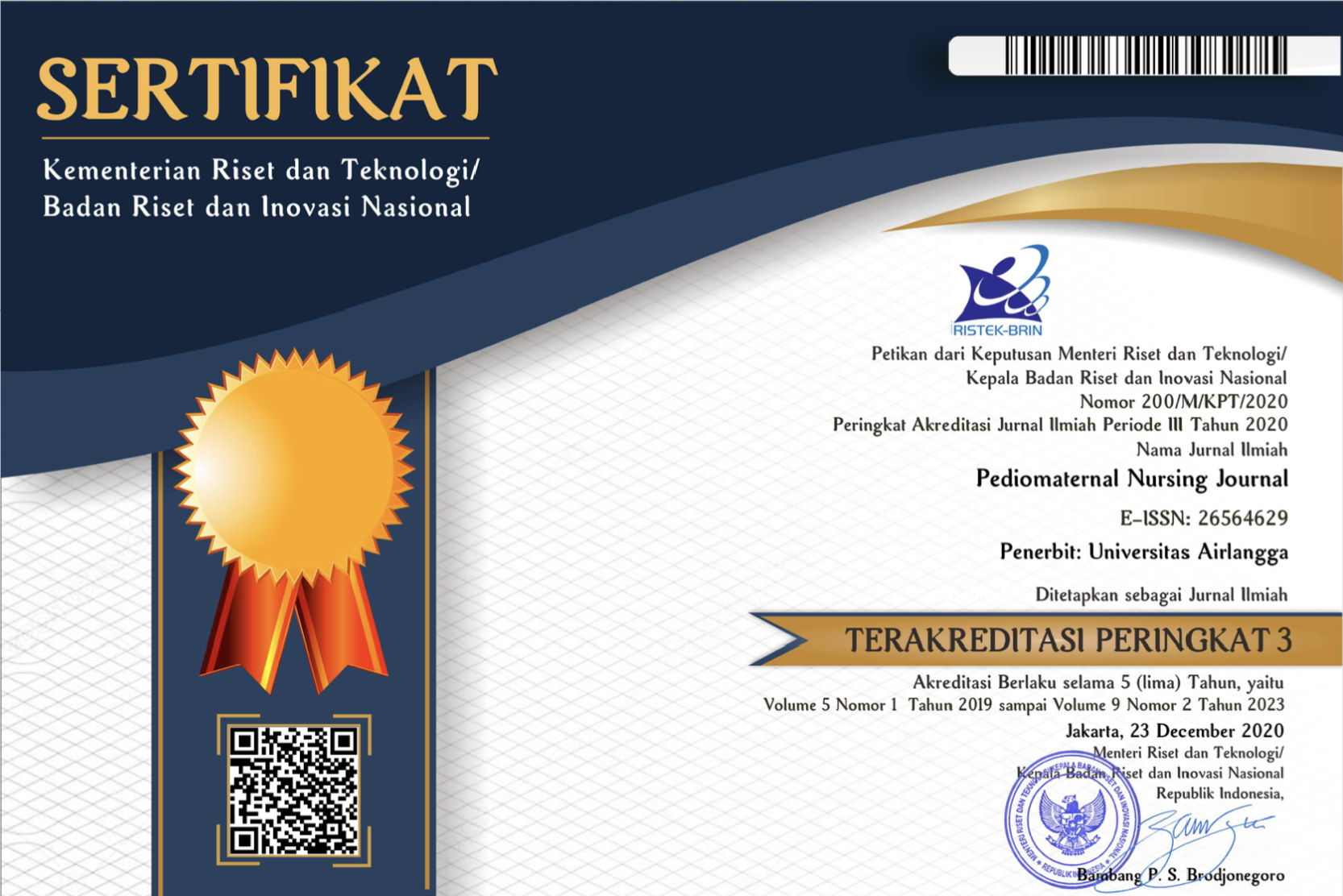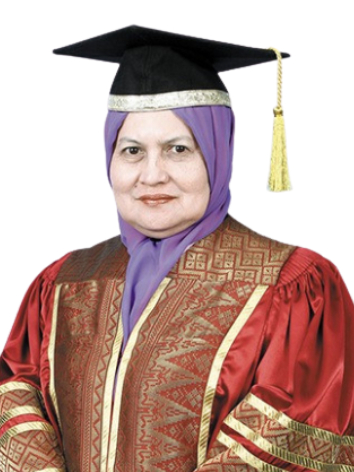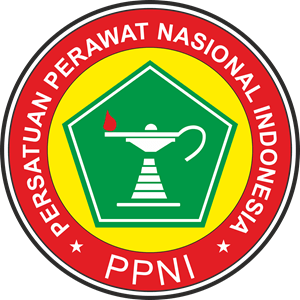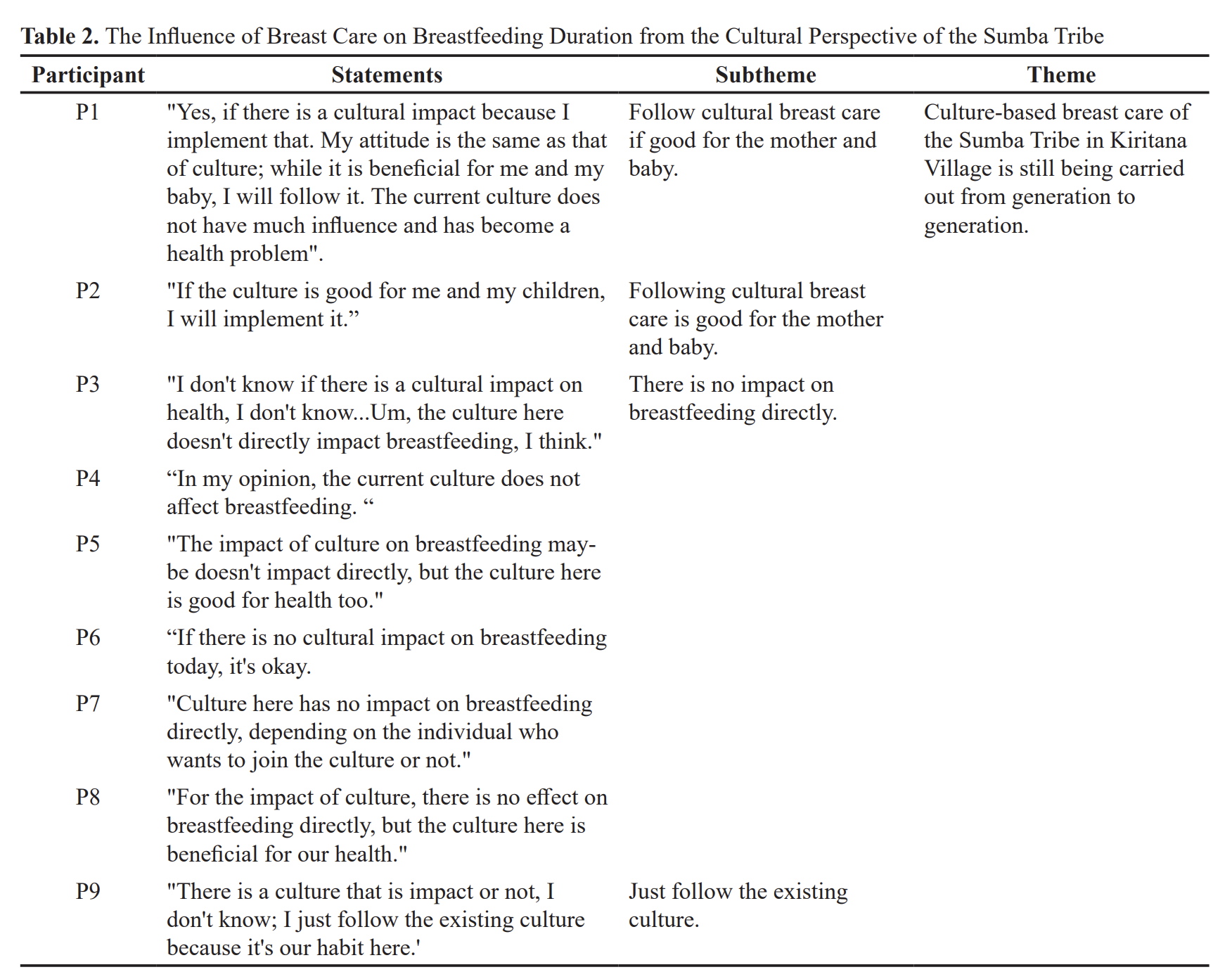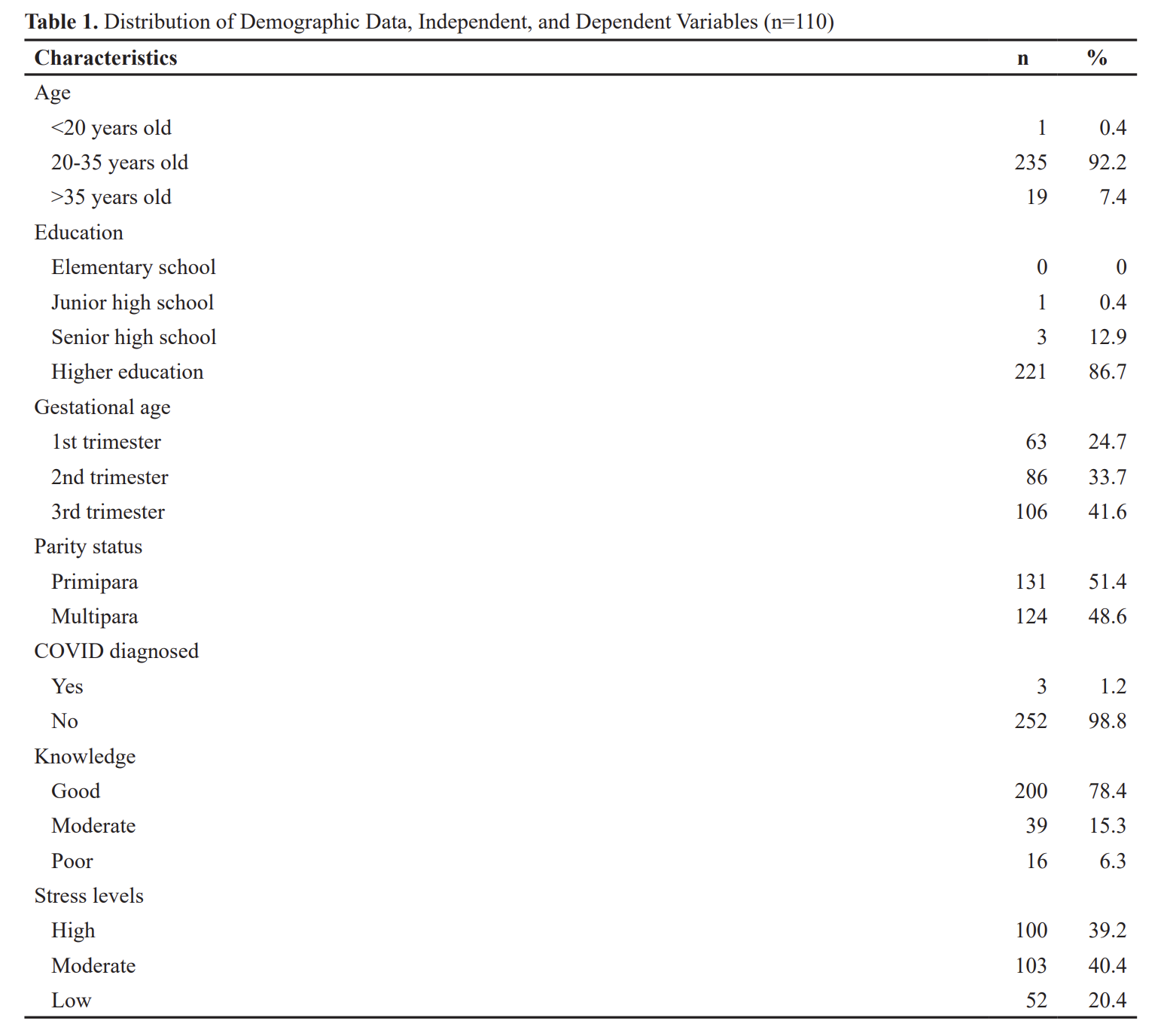A Qualitative Evaluation Study of The Infant and Young Child Feeding Counselling
Downloads
Introduction: The Infant and young child feeding (IYCF) counselling program is an international strategy to improve IYCF practices in the community. This study aimed to explore the implementation of the program through the logic model approach.
Methods: A qualitative method was employed for this evaluation study. Fifteen participants were selected by purposive random sampling, and data collection was conducted by in-depth interview, focus group discussion, observation, and document study. Data were processed from transcription, reduction, coding, categorizing to data interpretation and assessed by content analysis.
Results: IYCF training is a cascading training and a combination of adult and fun learning that effectively produces a mixture of counsellors who can provide counselling using the counselling cards. However, the gap in the number of cadre counsellors and the target of counselling, as well as the limited time, low financial support, over workload, and inadequate supervision, resulted in poor recording and low numbers of clients who had been exposed to counselling. Nevertheless, this counselling has a positive effect on maternal knowledge and attitude. Still, the existence of traditional community practices, family and environmental factors are barriers to the implementation of proper IYCF practices.
Conclusion: IYCF counselling effectively improved IYCF practices, so it has to be continued with strengthening the number of counsellors, recording and supervision activities. Changing strategy in counselling by involving other adult household members like grandmother or neighbours are explicitly targeted for more effective in improving the practices of infant and young child feeding.
Agumasie Semahegn, Gezahegn Tesfaye, A. B. (2014). Complementary feeding practice of mothers and associated factors in Hiwot Fana Specialized Hospital, Eastern Ethiopia. Pan African Medical Journal, 8688, 1–11. https://doi.org/10.11604/pamj.2014.18.143.3496
Armar-klemesu, M., Ruel, M. T., Maxwell, D. G., Levin, C. E., & Morris, S. S. (2000). Community and International Nutrition Poor Maternal Schooling Is the Main Constraint to Good Child Care Practices in Accra 1. October 1999, 1597–1607.
Badan Pusat Statistik. (2017). Survey Demografi dan Kesehatan Indonesia 2017. 60. https://doi.org/10.1111/j.1471-0528.2007.01580.x
Clapham, K., Manning, C., Williams, K., O'Brien, G., & Sutherland, M. (2017). Using a logic model to evaluate the Kids Together early education inclusion program for children with disabilities and additional needs. Evaluation and Program Planning, 61, 96–105. https://doi.org/10.1016/j.evalprogplan.2016.12.004
Cunningham, K., Nagle, D., & Singh, S. (2021). Associations between parents' exposure to a multisectoral programme and infant and young child feeding practices in Nepal. 17(January), 1–12. https://doi.org/10.1111/mcn.13143
Dewey, K. G. (2016). Review Article Reducing stunting by improving maternal , infant and young child nutrition in regions such as South Asia : evidence , challenges and opportunities. 12, 27–38. https://doi.org/10.1111/mcn.12282
Firdausya, T. J., & Hardini, D. S. (2020). The Correlation between Mothers' Breastfeeding Pattern and Stunting among Toddlers. Pediomaternal Nursing Journal, 6(2), 108. https://doi.org/10.20473/pmnj.v6i2.19943
Foundation, W. K. K. (2014). W.K. Kellogg Foundation Logic Model Development Guide.
Government Regulation No. 33 in 2012 about the provision of milk, (2012).
Gupta, A., Suri, S., Dadhich, J. P., Trejos, M., & Nalubanga, B. (2019). The World Breastfeeding Trends Initiative: Implementation of the Global Strategy for Infant and Young Child Feeding in 84 countries. In Journal of Public Health Policy (Vol. 40, Issue 1). https://doi.org/10.1057/s41271-018-0153-9
Havemann, K., Pridmore, P., Tomkins, A., & Garn, K. D. (2012). What works and why ? Evaluation of a community nutrition programme in Kenya. 16(9), 1614–1621. https://doi.org/10.1017/S1368980012004880
Indonesian Millenium Challenge Account. (2015.). Community based health and nutrition to reduce stunting.
Indonesian Ministry of Health Regulation No. 25 in 2014 about Baby Health Services, (2014).
Karmacharya, C., Cunningham, K., & Choufani, J. (2017). Grandmothers' knowledge positively in fl uences maternal knowledge and infant and young child feeding practices. 20(12), 2114–2123. https://doi.org/10.1017/S1368980017000969
Kathyrn Dewey. (2001). Guiding Principles for Complementary Feeding of the Breastfed (PAHO and WHO). Pan American Health Organization and World Health Organization, 18–25. https://doi.org/10.1017/S1368980011002485
KEMENTERIAN KESEHATAN REPUBLIK INDONESIA. (2014). Modul Pelatihan Konseling : Pemberian Makan Bayi dan Anak. 21.
Khan, G. N., Ariff, S., Khan, U., Habib, A., Umer, M., Suhag, Z., Hussain, I., Bhatti, Z., Ullah, A., Turab, A., Khan, A. A., Garzon, A. C., Khan, M. I., & Soofi, S. (2017). Determinants of infant and young child feeding practices by mothers in two rural districts of Sindh, Pakistan: A cross-sectional survey. International Breastfeeding Journal, 12(1), 1–8. https://doi.org/10.1186/s13006-017-0131-z
Kohli, S., & Chadha, R. (2017). Knowledge and Counselling Skills of Community Health Workers for Promotion of Optimal Infant and Young Child Feeding (IYCF) Practices: A Review. International Journal of Health Sciences and Research, 7(10), 240–248.
Lamstein, S. A. (2017). Women' s empowerment in Nigeria : baseline data from an evaluation of the Community Infant and Young Child Feeding ( C-IYCF ) Counselling Package. The Lancet Global Health, 5, S29. https://doi.org/10.1016/S2214-109X(17)30136-5
LYDIA C. MEDEIROS, PHD, RD1 ; SUE NICHOLSON BUTKUS, PHD, R. ;, HELEN CHIPMAN, PHD, RD, LN3 ; RUBY H. COX, PHD, RD4 ; LARRY JONES, P. ;, & DEBORAH LITTLE, E. (2005). A Logic Model Framework for Community Nutrition Education. J Nutr Educ Behav, 37, 197–202.
Manikam, L., Robinson, A., Kuah, J. Y., Vaidya, H. J., Alexander, E. C., Miller, G. W., Singh, K. K., Dawe, V., Ahmed, S., Lingam, R., & Lakhanpaul, M. (2017). A systematic review of complementary feeding practices in South Asian infants and young children : the Bangladesh perspective. 1–13. https://doi.org/10.1186/s40795-017-0176-9
Mekonnen, N., Asfaw, S., Mamo, A., Mulu, Y., & Fentahun, N. (2018). Barriers and facilitators of child-feeding practice in a small sample of individuals from Gozamin District , Northwest of Ethiopia : a qualitative study. 1–7.
Rahmawati, S. M., Madanijah, S., Anwar, F., & Kolopaking, R. (2019). The effectiveness education of counselling of infant and young child feeding as intensive to improve counselling performance of Posyandu cadres in Bogor, Indonesia. International Journal Of Community Medicine And Public Health, 6(6), 2280. https://doi.org/10.18203/2394-6040.ijcmph20192138
Ruel, M. T., & Menon, P. (2002). Community and International Nutrition Child Feeding Practices Are Associated with Child Nutritional Status in Latin America : Innovative Uses of the Demographic and Health Surveys 1 , 2. October 2001, 1180–1187.
Shi, L., & Zhang, J. (2011). Recent evidence of the effectiveness of educational interventions for improving complementary feeding practices in developing countries. Journal of Tropical Pediatrics, 57(2), 91–98. https://doi.org/10.1093/tropej/fmq053
Yawson, A. E., Amoaful, E. O., Senaya, L. K., Yawson, A. O., Aboagye, P. K., Mahama, A. B., & Selenje, L. (2017). The lancet series nutritional interventions in Ghana : a determinants analysis approach to inform nutrition strategic planning. 1–8. https://doi.org/10.1186/s40795-017-0147-1
Copyright (c) 2021 Fitria Nurwulansari, Deni Kurniadi Sunjaya, Dida Akhmad Gurnida, Dewi Marhaeni Diah Herawati, Ieva Baniasih Akbar

This work is licensed under a Creative Commons Attribution 4.0 International License.
1. The journal allows the author to hold the copyright of the article without restrictions.
2. The journal allows the author(s) to retain publishing rights without restrictions.
3. The legal formal aspect of journal publication accessibility refers to Creative Commons Attribution (CC BY).

